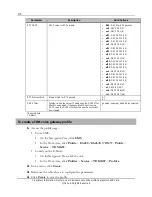
158
Proprietary Information: Not for use or disclosure except by written agreement with Calix.
© Calix. All Rights Reserved.
Creating a Dial Plan and Rules
This topic describes how to create and delete a number plan table that is assigned to a SIP
gateway service provisioned on a Voice port.
Number plans are used to identify specific types of phone numbers dialed by a subscriber,
and to process the number before transmission by deleting, replacing, or adding digits
according to the relevant rule. The rule can also automatically add the country code and
national destination (region) code, or deny the number pattern entirely.
If a custom numbering plan is not applied when you create a SIP gateway service, the default
numbering plan table (Access) is applied which contains a generic digit entry rule and a rule
for 911 calling. Up to twenty number plans may be created per E-series node or modular
chassis system.
See the "Dial Plan Example" section in the
Calix Application Note: Using the ONT VoIP
Configuration Files
for an example of a dial plan and an explanation of each code and its
function.
Configuration considerations
On legacy systems, the dial plan is embedded in the SIP gateway object.
On current systems using the SIP Gateway with per-port provisioning method, a separate
SIP dial plan profile can be created and attached to the SIP port service.
When an applied dial plan is modified, the modification is pushed down to the
configured ONTs with no further input.
T-Series ONTs only accept H.248 standard dial plan rules via OMCI. However,
enhanced dial plan symbols are supported through the XML voice configuration files.
The following restrictions apply when creating dial plan rules:
A “|” rule separating character is required at the end of each rule, which limits the
rule to 27 characters per the G.984.4 OMCI table entry length.
When creating the rule through CLI, the pattern must begin with a “^” to indicate
the start of a rule.
In general, dial plan rules are wrapped in parentheses with an open parenthesis before
the first rule and a closing paren following the last rule within the dial plan.
Each table row allows for 28 bytes (27 for the rule plus one for the
separator/terminating character); if multiple rules can fit within a single row, they will
be separated by the “|” indicator.
Repeated ranges (a range followed by {n}) get expanded out before being sent to T-
Series ONTs, when the range is not [0-9].
For example, [0-9] {5} will not expand larger (it will be xxxxx) but [1-9] will expand
larger as [1-9][1-9][1-9][1-9][1-9], and the total length must not exceed 28 bytes.
















































